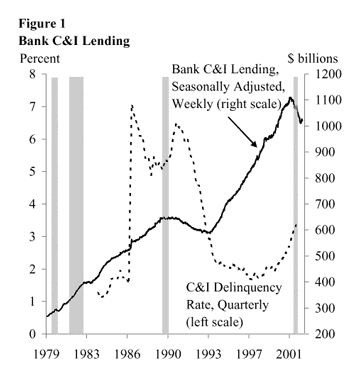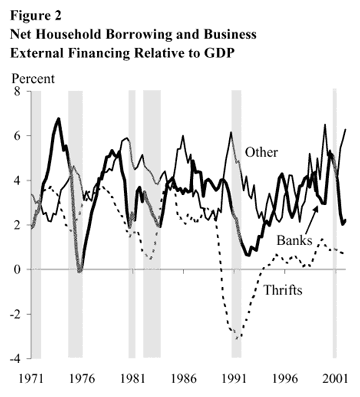Recently, some concerns about a “credit crunch” in the U.S. economy have appeared in the business press. In the commercial paper market, a number of large firms were reportedly unable to borrow from this market, as investors reassessed the credit risk of these firms amid growing accounting concerns.
Western Banking Quarterly is a review of banking developments in the Twelfth Federal Reserve District, and includes FRBSF’s Regional Banking Tables. It is normally published in the Economic Letter on the fourth Friday of January, April, July, and October.
Recently, some concerns about a “credit crunch” in the U.S. economy have appeared in the business press. In the commercial paper market, a number of large firms were reportedly unable to borrow from this market, as investors reassessed the credit risk of these firms amid growing accounting concerns. In the bank loan market, total commercial and industrial (C&I) lending has fallen quite substantially. Business credit is the lifeblood of economic activity, so it is very important that the credit market function properly and smoothly. This Economic Letter examines recent developments on credit availability to businesses, focusing specifically on the issue of a credit crunch, or credit rationing, in which creditworthy borrowers are denied credit.
Commercial paper—short-term, unsecured promissory notes issued by corporations—is a low-cost alternative to bank loans. In order to offer commercial paper at competitive rates, the issuers must be large and reputable firms, so that institutional investors can trust in their creditworthiness. The market for nonfinancial commercial paper has grown rapidly in recent years, peaking at $351 billion in November 2000. Since then, it has fallen over 40% to about $200 billion. While some of the recent drop-off was related to the well-publicized problems faced by a few large companies that could no longer tap the commercial paper market, the decline started much earlier. Part of the decline is due to the softening demand for short-term financing as economic activity slowed in early 2001. Indeed, the current downturn in commercial paper started just a few months before the economy went into a recession.
It is important to gain some perspective on the recent instances where a number of large firms were shut out of the commercial paper market. In providing very short-term, unsecured financing, commercial paper investors place a high value on safety, and they deal almost exclusively with only high-quality borrowers. Thus, whenever there is even a small doubt about a firm’s creditworthiness, investors simply bypass this firm’s commercial paper altogether. At the same time, it may not be economical for the firm to raise its commercial paper yield to entice investors, as the firm may find it cheaper to borrow from a specialized lender like a bank, which usually provides back-up lines of credit to commercial paper issuers. Thus, the recent episode reflects more about how the commercial paper market works than about an environment of unusual credit rationing. So far, there is little evidence to suggest that high-quality borrowers cannot access this market.
In addition, the interest rate on high-grade commercial paper continues to track the default-free Treasury rate very closely. Thus, there is no sign that high-quality borrowers have to pay more on commercial paper financing. Nevertheless, the spread between the highest grade and the second-tier commercial paper has widened somewhat recently. This may be due to the heightened sensitivity to credit risk in this market amid growing concerns about accounting practices and transparency among several large commercial paper issuers. Overall, the relatively small interest rate differentiation in the commercial paper market again suggests that only high-quality borrowers can access this market.
In the bank loan market, commercial banks also have been tightening their standards for C&I lending to both large and small borrowers for quite some time, as indicated in the Federal Reserve Senior Loan Officer Opinion Survey (2002). At the same time, the survey also points to falling loan demand faced by banks amid a slowing economy. With both supply and demand factors at work, seasonally adjusted bank C&I lending has fallen 7.5% to around $1 trillion since the recession started (Figure 1), a much steeper decline than in prior recessions.

At issue in determining whether there is a credit crunch is what is happening on the supply side. Specifically, are the tighter lending standards a response to the changing creditworthiness of the borrowers, or are they driven by something else? Tightening in response to declining repayment capability of the borrowers is a rational business decision that is the key to a healthy banking sector; however, tightening that is unrelated to the borrowers’ fundamentals is a cause for concern. So far, the evidence seems to suggest the former, not the latter.
First, the C&I loan delinquency rate has been climbing steadily since 2000 and shows signs of acceleration towards the end of 2001 (Figure 1). Part of the pickup in loan defaults has to do with banks’ lax lending standards during the boom years. Thus, facing a growing bad loan problem, it seems logical for banks to rein in their lending standards to be more in line with economic fundamentals. Second, the slowing economy was expected to worsen borrowers’ repayment capability going forward. Indeed, the Loan Officer Survey indicated that concerns about the economic outlook were the main reason banks tightened their lending standards. Hence, while some borrowers may see their credit rating downgraded by banks and must incur higher borrowing costs, other marginal borrowers would no longer meet the bank’s minimal lending standards and must be denied credit. Quite clearly, this kind of tightening is a rational response to the borrower’s changing condition and should not be confused with credit rationing. Third, banks in general are highly profitable and have strong capital positions. Unlike the early 1990s, when banks restrained lending due to low capital, now we do not seem to see readily identifiable supply factors in the banking industry that may cause banks to refuse to lend to creditworthy borrowers.

Finally, data on total credit flows indicates that, while C&I loans and commercial paper volume are contracting, total business debt is still growing at a healthy pace. In particular, Figure 2 shows that the decline in bank lending is more or less offset by the robust credit extension by other lenders, including finance companies, long-term bond holders, as well as real estate and other asset-based lenders. This was not the case in prior recessions.
The significant drop-off in nonfinancial commercial paper and the sharp decline in bank C&I lending have raised concerns about credit availability to business borrowers. But so far, there is no indication that truly creditworthy borrowers cannot obtain credit, as evidenced by the healthy growth in total business debt. The declines in commercial paper and C&I lending both coincided with slowing economic activity and are consistent with falling demand for short-term credit by businesses. To the extent that firms that were squeezed out of the credit market are indeed marginal borrowers, this is nothing more than normal market forces at work.
Simon Kwan
Research Advisor
Opinions expressed in FRBSF Economic Letter do not necessarily reflect the views of the management of the Federal Reserve Bank of San Francisco or of the Board of Governors of the Federal Reserve System. This publication is edited by Anita Todd and Karen Barnes. Permission to reprint portions of articles or whole articles must be obtained in writing. Please send editorial comments and requests for reprint permission to research.library@sf.frb.org